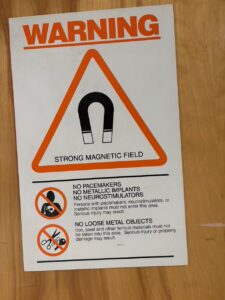Small spaces
I’m no fan of feeling confined, so when my doctor told me that I needed an abdominal MRI, I immediately flashed on what it might be like to lie inside a metal tube whose walls were only inches from my face. I’d never had an MRI before. Would I have a panic attack? My unruly mind coughed up a classic image of claustrophobia: Uma Thurman buried in a coffin in the movie “Kill Bill,” struggling for breath as she battles her way to the surface. Claustrophobia is a favorite theme of horror movies. Search online and you’ll find lists of horror films about being trapped in caves.
But what elicited the most dread was my own history of claustrophobia. Twenty-five years ago, I was arrested in Washington, DC, in a protest of the Administration’s intention to expand drilling in the Arctic National Wildlife Refuge. It was the first time I’d been arrested. Convinced of the righteousness of our cause, I was reasonably calm when the arresting officer cuffed my hands behind my back, seated me and my colleagues inside the police van, lowered a metal bar across our chests, and fastened another bar across our shins. Once our group was tightly secured, the van door swung shut. We sat in semi-darkness and waited for the van to move.
 The other women were chatting merrily with each other, but I found that I couldn’t join in. I felt increasingly uneasy and preoccupied. I couldn’t help noticing that I was locked in a metal box without windows and that I couldn’t get out. The air inside was close. The day outside was hot. Why wasn’t the van going anywhere? What if it grew too hot in here? What if the air ran out? What if the officers forgot about us? What if they couldn’t hear us if we shouted for help? What if they didn’t even care?
The other women were chatting merrily with each other, but I found that I couldn’t join in. I felt increasingly uneasy and preoccupied. I couldn’t help noticing that I was locked in a metal box without windows and that I couldn’t get out. The air inside was close. The day outside was hot. Why wasn’t the van going anywhere? What if it grew too hot in here? What if the air ran out? What if the officers forgot about us? What if they couldn’t hear us if we shouted for help? What if they didn’t even care?
My dear friend Andrea, a veteran of many arrests, looked kindly into my strained face. Was I OK? No? Then, she said, keep my eyes focused on hers. Stay in the present. Take a deep breath. I fought to pay attention, to keep my eyes on hers, and to rein in my runaway mind. When a guard momentarily opened the door, Andrea briskly announced that I was ill and needed fresh air. To my great relief, the guard lifted the metal bars and let me briefly step outside. Squinting in the sudden sunlight I inhaled great draughts of air and savored the view of open sky. My wrists remained cuffed, but I felt safe in the unfettered space. The experience of being locked up in jail still lay ahead, but for now, at least, I could pause to ponder the power of imagination run amok. I could breathe again. Uma Thurman climbs back to the surface.
Would having an MRI throw me into a similar panic? I consulted with friends.
“It’s no big deal,” said one. “It takes only twenty minutes. Piece of cake.”
“I did fine with my MRI,” another friend told me brightly. Then she pressed her lips together and looked away. “Until the last few minutes.”
“It was hard for me all the way through,” a third friend confessed. “Twice I had to ask the team to stop the procedure so that I could pull myself together.”
“I hated every minute,” someone else declared, shaking his head emphatically. “I couldn’t bear it. I started scrambling out backwards even though the technicians were yelling at me to stop, and I ended up falling on the floor.”
Well, I told myself, maybe I should get a prescription for anti-anxiety medication. But wouldn’t that be cowardly? Part of me wants to be a self-sufficient hero who can take every challenge in stride. Isn’t that’s what spiritual warriors do? My first teacher of vipassana Buddhist meditation apparently would boast that he never took Novocain while undergoing dental work – he simply stayed mindful and breathed through the sensations of what ordinary mortals dread. I admired his valor, but – coward or not – I wasn’t that sort of spiritual hero. I would accept my vulnerability, make use of the tools available to ease suffering, and try a mild sedative.
We moderns undergo all kinds of ordeals for the sake of healing: we submit to modern technology, put ourselves at the disposal of forceful magnetic fields and radio waves, and lie motionless in a very small space. It can help to have friends to talk to and a prescription to help quiet the mind. And, if spiritual warriorship isn’t about toughing it out and going it alone, maybe another kind of spiritual practice can help: Engaging the imagination in a way that serves life. A wise friend suggested imagining the procedure as a kind of ceremony, as an invitation to draw close to the Source of love and life. Since time immemorial, Hopis and other Pueblo peoples have carried out sacred rituals in underground chambers called kivas. Perhaps an MRI – despite its noise, force, and mechanical sophistication – could function as a kiva, as an underground place of spiritual deepening and transformation.
On the morning of my MRI, I woke up relatively calm and curious. I wasn’t unduly anxious, and I gratefully gave credit to the anti-anxiety medication. Like an initiate preparing for ceremony, I fasted from food and water for several hours. I prayed to Divine Mother, asking her to be with me. I wondered if repeating the Hail Mary would keep me calm during the procedure. My kind husband drove me to the hospital, I changed into a hospital gown, and then, accompanied by a technician, I stepped onto a lift that raised us to a set of closed doors. I waved goodbye to my husband below. The doors opened. The technician and I stepped into a new space and the doors closed behind us.

At first glance, the MRI reminded me of a vagina. Now I understood: I was about to return to my mother’s body. What a surprise! I thought of Jesus summoning Nicodemus to be born again (John 3:1-21). Baffled, Nicodemus goes all literal and asks whether someone can enter a second time into the mother’s womb and be born. As in, What the hell are you talking about? Well, I didn’t mind if entering an MRI was an opportunity for new birth and transformation – as in, Why the hell not? Maybe a mothering God was with me.
The machine issued regular pulsing sounds. The technician explained that cooling fans were maintaining a low temperature to create a strong magnetic field. Whatever the explanation, I liked what I was hearing: it could have been a creature’s breathing, or maybe its heartbeat. Imagination and curiosity kept me company as I was strapped down on the table, let a nurse search my veins for an IV, and had headphones placed over my ears. When the technician fastened something like a large, curved shield across my chest, I decided with satisfaction that this was my carapace and that I was a turtle. After I (Turtle) slid into the tube and the loud pounding began, I listened with interest to the changes in volume, speed, and pitch. It was a noisy kiva. I noticed that a repetitive series of ratatatat beats could have been made by a woodpecker. I greeted the woodpecker.
I emerged from the MRI intact, though whether I was in any way transformed remains to be seen. Kivas keep their secrets. Down the road, perhaps, when I find myself again in a very small space – inside another MRI or inside another jail cell, the latter possibility looking ever more likely as our government speeds toward autocracy and as the need for resistance grows – I’ll find out if I learned any enduring lessons from today’s MRI. For the time being, what strikes me is how malleable our perceptions of the world can be. Mastering our imagination – that is, letting it play and run free while keeping it firmly tethered like a kite to a place of calm – can help us move with some ease through an otherwise difficult experience. When so much is closing in on us right now, I’ll keep trying to transform fear into a calm, creative response.
______________________________________________________________________________________________________________
In this brief YouTube video, my husband, Robert Jonas, plays shakuhachi (Japanese bamboo flute) in a kiva at Mesa Verde National Park, Colorado.
Leave a Reply

8 Responses to “Small spaces ”
Trish Callard
Margaret
I too am claustrophobic and hate tunnels, elevators and feeling shut in. I was inspired by your imagination and visualization of a kiva and hearing a woodpecker pecking with your MRI
You became curious and allowed the machine to do its work..I was encouraged by the creative ways you embraced this scary experience turning it around and to take that approach to whatever feels foreign and scary
Blessings on this wisdom
Trish
mbj
Thank you, Trish, from one person who gets claustrophobic to another! It felt empowering to work with each sensation and impression in an active way, letting my imagination support rather than sabotage me. Thanks for understanding.
Sue Swanson
Thanks, Margaret, for the lovely images. I am especially thinking of the womb image and second birth. May the medical results of your MRI be as positive as the psychological and spiritual ones!
mbj
Thank you, Sue. Let’s all be re-born anew (and stay healthy as long as we can!).
Lorienne
I completely share the claustrophobia. I just turned down having an MRI for that reason. There’s something wrong with my wrist and I’m just not gonna find out what it is. I’ll keep you in my prayers and hope that results are good.
mbj
Thank you for your comment, Lorienne. I am as surprised as anyone that I made friends with the MRI experience, so I hope you won’t rule that out. Otherwise, I hope you find an alternative path for healing your wrist. Blessings to you!
Tessa
Thanks for sharing this experience. I’ve always been nervous about the possibility of ever having a mri. I will remember your experience and refer to it if and when. I hope the results were helpful and that all is quite well with you.
mbj
Good news medical update: MRI results show no sign of cancer. The issue is relatively minor and will be dealt with down the road. I am thankful.